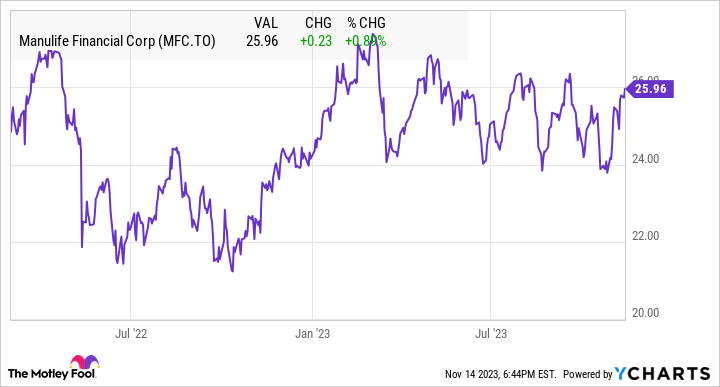Is Manulife Stock a Buy, Hold, or Sell?

Written by Kay Ng at The Motley Fool Canada
Manulife (TSX:MFC) is an interesting stock that investors might scratch their heads over. It has done a good job in maintaining or increasing its common stock dividend over the last decade. (Its adjusted earnings per share (EPS) are also up 10.7% per year in the past 10 years.) However, the stock price has not delivered the appreciation expected of a good stock. In the period, its stock price is up about 32%, which comes out to only approximately 2.8% per year.
Thankfully, after throwing in its dividends, combined with price appreciation, the total return was almost a double at close to 99%, which equates to a more acceptable total return of about 7.1% per year. For reference, the Canadian stock market return was about 7.5% annually in the period.
Manulife’s recent results
Manulife just reported its third-quarter (Q3) results last week. Based on a constant exchange rate basis, core earnings were up 28% to $1.7 billion. Core EPS climbed 35% to $0.92. Management noted solid growth in Asia, with a 33% increase in core earnings. For the quarter, the life and health insurance company also delivered core return on equity (ROE) of 16.8%, an improvement from 12.7% a year ago.
The year-to-date results show a bigger picture. Core earnings climbed 12% to $4.9 billion. Helped by share buybacks, core EPS rose 20% to $2.55. Its core ROE was 15.7%, up from 13.9% a year ago. Furthermore, its adjusted book value per share rose 4% year over year to $30.67.
In the Q3 press release, Roy Gori, Manulife’s president and chief executive officer, also highlighted that the company “delivered resilient results in Global Wealth Asset Management with sequential core earnings growth, improving core EBITDA [a cash flow proxy] margin and positive net flows of $5.8 billion over the past three quarters.”
The Asian market has higher growth potential
Manulife is optimistic about the growth in Asia. Currently, it has about a third of its business there. Gori is eyeing the growing middle class in Asia. In the Scotiabank Financials Summit presentation in September, Gori stated that “we’ve got two billion people in the middle class of Asia in 2020, growing to 3.5 billion people. That means Asia will represent two-thirds of the world’s middle class by 2030. And that’s fueling GDP growth. GDP growth in Asia has been significantly higher than it has been in the rest of the world. The forecast for the next 12 months is for GDP growth to be between 4% and 5% when you aggregate Asia, which is a many multiple of North America and Europe.”
Having been in Asia for more than 125 years, Manulife has a good understanding of winning business there. Gori further noted that “China does represent some challenges and headwinds.” However, it pointed out that Mainland China only represented 1% of Manulife’s core earnings.
How does higher interest rates affect Manulife stock?
The Scotiabank Financials Summit presentation touched upon interest rates. Gori stated, “We think higher rates are actually a very big positive for us. If anything, many parts of our older business provide a hedge against inflation because they are real assets, [which] deliver better returns in an inflationary environment.”
How have higher interest rates affected Manulife stock? As the graph below shows, although with ups and downs (as expected of stocks), the MFC stock price has held steady in today’s rising interest rate environment.
MFC stock price data by YCharts
Is Manulife stock a buy, hold, or sell?
Over the last decade, the stock’s valuation compressed from a price-to-earnings (P/E) ratio of about 13.9 to 7.7 times. At $25.96 per share at writing, it also offers a nice dividend yield of 5.6%. Its dividend is sustainable and has room to grow.
Let’s be super conservative and assume a target P/E of of 8.5 and EPS growth rate of 6%; the dividend stock can still deliver respectable annualized returns of approximately 12% per year over the next five years. Therefore, Manulife appears to be a good consideration for buying and holding.
The post Is Manulife Stock a Buy, Hold, or Sell? appeared first on The Motley Fool Canada.
Should You Invest $1,000 In Manulife?
Before you consider Manulife, you'll want to hear this.
Our market-beating analyst team just revealed what they believe are the 5 best stocks for investors to buy in November 2023... and Manulife wasn't on the list.
The online investing service they've run for nearly a decade, Motley Fool Stock Advisor Canada, is beating the TSX by 24 percentage points. And right now, they think there are 5 stocks that are better buys.
See the 5 Stocks * Returns as of 11/14/23
More reading
Fool contributor Kay Ng has positions in Bank Of Nova Scotia and Manulife. The Motley Fool recommends Bank Of Nova Scotia. The Motley Fool has a disclosure policy.
2023

 Yahoo Finance
Yahoo Finance 
